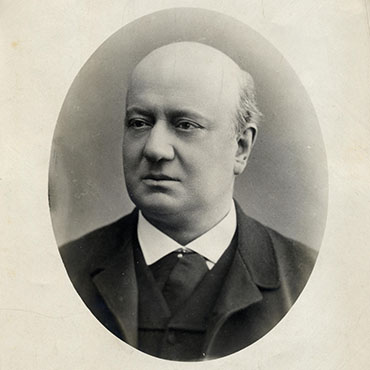Guasti was born in Prato in 1822, the son of a small printer and bookseller with a rural background. The family, which included more than one priest, brought him up according to strict religious principles. Giuseppe Silvestri, a priest with liberal ideas and director of the Collegio Cicognini, to whom Guasti always remained so close as to write his biography, admitted Guasti as an external student, until he was recalled to the printing house by his father to help as a proofreader. The ideas of the Risorgimento lived in him, together with strong religious ideas, and while he attended the literary circle of the lawyer and printer Giovacchino Benini, a meeting-place of some of the greatest Florentine intellectuals of a liberal bent, he became close to Francesco Frediani, a Franciscan teacher of religious eloquence at San Domenico in Prato, who attracted around himself a circle of educated Catholics. Guasti was influenced by this environment, to the extent that at little more than twenty years of age he became a member of the Third Order of Franciscans and in 1846 translated the Storia di San Francesco d’Assisi by Émile Chavin de Malan.
In line with the project of Niccolò Tommaseo, who was planning to produce a history of Italy starting with the stories of the individual municipalities, he started his work on the history of Prato and founded the “Calendario pratese”, a cultural and political journal of local history strongly influenced by moderate Catholicism and the ideas of Gioberti, for which he wrote many learned articles based on original documents. As an active patriot during the events of 1848, he was always against democratic demands, in that he maintained an idea of politics as elitist and in line with the institutions of the Grand Duchy, far removed from the more radical ideas of Giuseppe Montanelli’s government.
He took refuge in his studies, but after the restoration of the Grand Duke he was called to be archivist of the Opera del Duomo in Florence, where he had at his disposal the mass of materials that would make up the focus of his work on the dome and the construction of the church and of the bell-tower of Santa Maria del Fiore. He had strong relationships with the major figures in the Florence of his time, including Ubaldino Peruzzi, who even offered him accommodation, Giovan Pietro Vieusseux, who asked him to be one of the regular collaborators to the “Archivio storico italiano” and Gino Capponi, who relied on his help in writing the Storia della Repubblica di Firenze. He had connections with all the main academies of the city, such as la Colombaria and la Crusca, of which he was secretary during the period when Augusto Conti was Archconsul.
When in the middle of the 1850s the government set up the Central Archive of the Tuscan State, Guasti had the role of assistant to the first superintendent Francesco Bonaini, with responsibilities for the Archivio delle Riformagioni and the Diplomatico. He became effective superintendent when Bonaini’s health started to falter, and inherited his post officially in 1874, leaving a marked impression on archival science nationally with the organisation of several institutes and with his contribution to the commission for the organisation of State archives.
He was a fervent admirer of Savonarola rather than a scholar and he contributed to the discussion that ran for a long time in the pages of the “Archivio storico Italiano”, adopting the uncritical stance of a latter-day Piagnone [follower of Savonarola], which attracted criticisms of fanaticism and superstition. Politically he was against the mixing of the temporal and spiritual power of the Church, which led to a collision with the Jesuits of “Civiltà Cattolica”, convinced as he was that State and Church could be reconciled, each maintaining its own role. But the situation in Rome so sickened him as to cause him to abandon politics and dedicate himself to study, thus producing to a host of learned writings, where he never missed the opportunity, when the chance presented itself, to praise the morality of mediaeval customs against the corruption of the period of the Medici and the Renaissance, in which he saw the origin of many of the evils of his time.
What stand out from the mass of work are the inventories of collections and the editions of archival documents, compiled with exemplary methodology. Cesare Guasti died in Florence in 1889 and was not able to see even the first volume of the national edition of Galileo. Nevertheless, Guasti was one of the few that was praised by Antonio Favaro, who had got to know him during his first journey searching for material of Galileo preserved in Florence. Favaro, who owed to this contact his first meeting with Isidoro Del Lungo, when he was able to put the seal of closure on the works at the Accademia della Crusca, chose to name him among few others: “It was our dear friend Cesare Guasti, whose paternal benevolence I can never recall without profound tenderness, who was the first judge of my audacious plan and encouraged me to persevere”.


